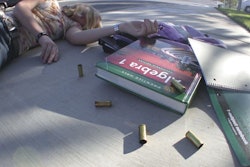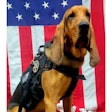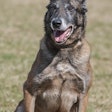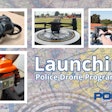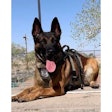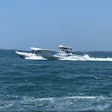Just before Christmas 2002, there was precious little peace on earth or good will toward men. The Washington Post reported that Al Qaeda had acquired nerve gas from the Iraqi stockpiles, the Orange County (Fla.) Sheriff’s Department requested that its 1,400 deputies volunteer for smallpox inoculations, and North Korea revived its nuclear weapons program.
Less than two years ago, weapons of mass destruction (WMD) such as gas, viruses, and nukes were mostly the stuff of Tom Clancy novels, not the everyday concern of the nation’s law enforcement. But that was before 9/11.
Now, every exhibit of police equipment looks like the dressing room for Armageddon. And if you look at the articles and ads in this or any other law enforcement publication, you’ll see respirators, hazardous materials suits, decontamination systems, and all kinds of WMD gear. It’s enough to convince you that you are about a million unfunded dollars and five years behind the curve, and that the end of your community as you know it is behind every bush or inside of every container ship or train car.
Don’t let it overwhelm you. Preparation for a WMD incident doesn’t need to take most of your agency’s budget.
Making the Pitch
Before you do anything, obtain a strong commitment from your agency head. Remember, WMD gear is important but it’s understandable that your chief, sheriff, or ranking officer sees greater need for cruiser tires, office supplies, and legal counsel. Budget limits are budget limits. So be prepared for the boss to say, “No.”
But do your best to get the green light. Start by making a small presentation to your command officers showing how probable the current threat is and what the potential outcome could be for your jurisdiction, including liability for the injury of unprepared responders. Then show them how little gear and training is actually needed and how much of it can be purchased with available grants. Finish your presentation with the promise of an aggressive media campaign to bolster the public’s faith in your agency, and you’ve formed an excellent foundation for further consideration.
Once you have buy-in from your commander, start networking. In the law enforcement community, no agency is an island. Before you reinvent the wheel, seek out other like-minded individuals. There are many informative Web pages, e-mail lists, and other sources for educating yourself on the subject. Try a Web search using the keywords “WMD grants federal.” And don’t forget to tap your local resources as well. Many companies will gladly loosen their purse strings to donate money for WMD gear, especially if they know it will be used to protect them.
OK, now that you have the funding, it’s time to determine what equipment you truly need. Don’t get too caught up in the glamor of these toys. Very few agencies can justify the purchase of a Fox NBC (nuclear, biological, chemical) vehicle. However, at a minimum, every agency should consider the following basic safety gear:
The Breath of Life
Respirators, commonly called “gas masks,” are an excellent purchase. Not only are they good for WMD events, but they are dual-purpose devices that are good for riots and postblast dust protection, too.
OK, so you’ve made the prudent decision to invest in respirators. That’s great. But do your homework before you go shopping. Many respirators, including the half-faced ones, and the “escape” models, are completely unsuitable for a WMD incident.
Also, this is no place for bargain hunting. Yes, you can get older U.S. military and foreign military surplus masks on the cheap, but don’t. OSHA has issued a finding that the older M17 series of masks present in virtually every law enforcement agency in the United States isn’t even certified for use outside of the military. Even if OSHA didn’t look down on the M17s, there aren’t any current NBC-rated filters for these units. That’s right, respirators are not only fragile items, but the filters have a shelf life, too.
Another important consideration when buying a gas mask is to avoid confusion. A WMD incident is going to bring its own chaos. Don’t add to it by buying your tactical team one type of mask and your patrol officers another. If you buy the same system throughout your agency, then you can use the same filters in all of them and officers who change assignments won’t have to be retrained on new masks.
For patrol use, avoid the self-contained breathing apparatus (SCBA) and positive pressure units. They require extra training and maintenance, and if they are not checked regularly, they could have empty air tanks or dead batteries when needed. They are best left to specially trained tactical units.
Your best bet is a full-face respirator with an NBC-rated facepiece and a canister that doesn’t impede the proper use of firearms. KX Defense, MSA, Scott, and Micronel Safety all produce excellent, easy-to-use NBC respirators.
Protective Covering
Garments that can protect officers from WMD incidents are not cheap. But they usually store well, and with the grants available, are easier to obtain now than later, when you need them.
Generally, there are three levels of protection afforded by WMD suits and these are designated A, B, and C. Level A suits are the ones most commonly seen modeled by hazardous materials teams. They keep everything out for a long period of time, but they require a moderate amount of training, and officers wearing them will need support staff to assist in dressing, undressing, and cleaning.
That leaves Levels B and C, and it really only leaves B. Level C suits basically do little more than keep particulate and light spray off of the responder. Your best bet is to go with a Level B suit. One-piece suits with hoods and booties are preferred because there are fewer routes of exposure, and whichever you pick, be certain that the fabric is gas-impermeable. The Saratoga Hammer suit produced by TexShield, the Lanx Fabric System from Xymid, and Kappler’s Saranex hooded coverall are all excellent examples of WMD protective apparel.
Regardless of which protective suit you choose, finish off the ensemble with gloves and booties made from butyl rubber or a similar nonreactive compound. Be sure to seal the booties and gloves to the suit with strips of duct or other strong tape.
Threat Assessment
One of the biggest problems facing first responders to WMD incidents is knowing when gas, biologicals, or radiation have been released. The sooner the responders know that an attack is under way, the more people they can save. Unfortunately, there are no practical and reliable canaries that can detect all the hazards in this very dangerous coal mine.
So be very wary of purchases in the area of detection, especially if the maker claims to have an easy-to-use product that detects multiple biological weapons. Snake oil abounds when it comes to bio weapon detectors, and the devices that do work are often very expensive, extremely fragile, and difficult to use.
Chemical and radiological agents are fortunately another story. Draeger produces a chemical detection system that trained responders can use to gauge the level of contamination by reading a color change in a graduated tube or tubes. Aramsco sells the field-proven disposable M256 Chemical Agent Detection Kit and M8/M9 Chemical Agent Tickets, all of which operate by exhibiting color changes when exposed to various agents. And Smiths and Iontrack both offer electronic chemical agent monitors.
Clean Up
Ideally, before you task personnel into the crisis area, referred to as the “Hot Zone” by the Haz-Mat guys, your Incident Commander should already have set up an area where contaminated persons can rotate out and pick up sustenance and gear without spreading whatever contamination they are working in.
Unfortunately, ideal scenarios rarely present themselves in police work. Lessons learned from Oklahoma City, and both World Trade Center attacks show that officers in the trenches are going to rush in without protective gear and try to establish order and save people. Therefore, any WMD incident is likely to result in many contaminated rescuers before anyone know it is a WMD incident. That means responders and walking wounded victims are going to have to be decontaminated.
There are two ways to go about decon. The best for small police agencies is to develop a mutual aid response plan that states you hand off that responsibility to your local fire department or hazardous materials unit. They have the trucks, the hoses, and the gear, and why duplicate a service that another public safety agency can provide?
Larger agencies have more options. You can work with the firefighters, set up your own decon unit, or both. If your department has invested in the proper gear and training and you have adequate personnel to provide this service, you would be remiss not to have adequate decon gear. For instance, Kohler makes a completely self–contained, portable decontamination trailer called Mobile Decon that was designed with the cooperation of the U.S. Army and is available in several sizes.[PAGEBREAK]
Crawl Before You Walk
Notice that we haven’t discussed anything about decon foams, response vehicles, satellite meteorological real-time receivers, robots, permanent installation line source detection arrays, or interactive response guides. While the aforementioned items could be valuable assets to agencies already possessing adequate safety and response equipment, they are luxuries that few can afford. Honestly, as a nation, we need to crawl before we walk.
Before you spend 10 grand of grant money on a chemical agent monitor system that may never be used operationally in your jurisdiction, consider spending it on communications infrastructure so that when something does occur, responders won’t have to carry three portable radios each. Don’t laugh; it’s happened.
A WMD incident will quickly sap your resources, but preparing for one doesn’t have to. Simple management practice, networking among affected parties, minimal investment in basic safety gear, expeditious use of grants, and adequate training will yield a cohesive, effective solution for your agency.
How Does a Gas Mask Work?
While initially appearing to be a simple garment, a respirator, more commonly known as a "gas mask," is in fact a complex piece of personal protective equipment.
Respirators consist of three basic assemblies, a filter assembly, a valve assembly, and a faceblank assembly. When the wearer inhales, the air from outside the mask flows through the filter, through the valve assembly, over the inside of the eyepiece (to prevent fogging) ; and into his or her body. Exhaled breath exits the mask through an exhalation valve.
While often overlooked, the faceblank is a critical part of the respirator. No faceblank on the market today can withstand all agents and industrial chemicals known; however, the better ones use Hycar plastic. This material not only offers more resistance to permeation, but also better withstands the microscopic tears and holes at the seams and faceblank that are common to lesser respirators.
Filters are another major concern. All NBC-rated filters consist of a mix of active and passive media. Most filters begin with a large screen to trap large particles, then a layer of activated charcoal, followed by another layer of activated material (usually proprietary to the manufacturer). The layers of activated material neutralize many chemical agents, but after so long, these materials, if used, will be clogged with agent, or will begin to deteriorate in storage.
That's why it is very important to monitor the expiration dates on your filters. And remember, if the filters have been opened, their lifespan decreases exponentially.
Filter positioning is also important. Before you buy a mask, look carefully at the position of the filter(s). Does it hinder shouldering a long arm? Is it at the end of a long hose that could be grabbed by a rioter? These are critical concerns for police gas masks.
Another element of a gas mask that can affect its utility in the field is the valving assembly. Valves are the only moving parts in a gas mask, and therefore they are subject to the most wear. Because the valves usually are plastic, they are subject to becoming gummy, and sticky, rendering the respirator inoperable.
When purchasing a respirator, look at your valve assembly. Is it simple to maintain? Also, is the voicemitter in a good place for communications? The MSA Advantage 1000/Millenium series can be ordered with two voicemitters, one for normal speech, and one in the right cheek for use with telephones and radio systems.
A Disaster by Any Other Name
A Weapon of Mass Destruction Incident (WMD) can be defined several ways, depending on whose manual you are perusing. For instance, you might hear a WMD event referred to as an NBC (Nuclear, Biological and Chemical), CBR (Chemical, Biological and Radiological), CBRNE (Chemical, Biological, Radiological, Nuclear, and Explosive), or BNICE (Biological, Nuclear, Incendiary, Chemical, and Explosive) incident.
Regardless of the divergent terminology, what all these terms refer to is an attack designed to cause panic or injury via the threat or utilization of a device (or devices) that releases a chemical agent, biological agent, radiological contamination, nuclear yield, or overpressure (blast) and fragmentation, sometimes in combination.
For more information:
Aramsco
www.aramsco.com
Draeger Safety
www.draeger.net
IonTrack
www.iontrack.com
Kappler
www.kappler.com
Kohler
www.kohlermobile.com
KX Defense
nbcdefense@kxindustries.com
Lanx Fabric Systems
www.lanxfabrics.com
Micronel Safety
www.diamondbacktactical.com
MSA
www.msanet.com
Saratoga Hammer
www.texshield.com
Scott
www.scotthealthsafety.com
Smiths
www.smithsdetection.com
Shawn Hughes is a 12-year veteran of law enforcement currently serving with the Union County (Tenn.) Sheriff’s Office. He is an expert in Public Safety Bomb Disposal and was a Recognized Hazardous Materials Technician and WMD expert long before 9/11.







